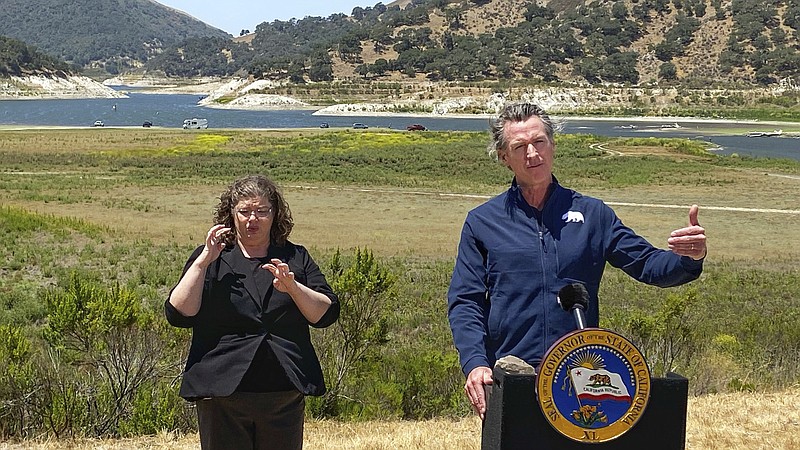SACRAMENTO, Calif. -- California Gov. Gavin Newsom on Thursday asked people and businesses in the nation's most-populous state to voluntarily cut how much water they use by 15% as the Western United States weathers a drought that is rapidly emptying reservoirs relied on for agriculture, drinking water and fish habitat.
The water conservation is not mandatory, but it demonstrates the growing challenges of a drought that will only worsen throughout the summer and fall and is tied to more intense wildfires and heat waves. Temperatures in parts of the region are spiking again this week but are less extreme than the record heat wave that may have caused hundreds of deaths in the Pacific Northwest and British Columbia in late June.
California's most important reservoirs are already at dangerously low levels and are likely to reach historic lows later this year.
Lake Oroville in Northern California is at 30% capacity and state officials worry water levels could get so low they might have to shut down a hydroelectric plant. Along the Russian River, officials fear Lake Mendocino could empty.
[Video not showing up above? Click here to watch » https://www.youtube.com/watch?v=eM_twFGbVrc]
"This is jaw-dropping, what's happening in the West Coast of the United States," Newsom said Thursday during a news conference at Lopez Lake, a reservoir in San Luis Obispo County formed by a dam on the Arroyo Grande Creek that is at 34% capacity.
A historic drought tied to climate change is gripping the U.S. West and it comes just a few years after California declared its last dry spell over in 2016. The previous drought depleted groundwater supplies and changed how some use water, with many people and businesses ripping out landscaping and replacing it with more drought-tolerant plants.
Compared with before the previous drought, urban water usage in California is down an average of 16%. But scientists say this drought is already hotter and drier than the last one, accelerating the impact on people and the environment.
California's Mediterranean climate means it doesn't get significant rain or snow until the winter. It relies on snowmelt in the mountains to fill its reservoirs in the spring, which then provide water for farms, homes and fish throughout the year.
Some big storms in January made officials optimistic about avoiding water shortages this year. The soil was so dry, however, that instead of melting into runoff to fill rivers and reservoirs, much of the snow in the mountains instead seeped into the ground.
"What we didn't understand was we had this deepening and intensifying drought underground," said Karla Nemeth, director of the California Department of Water Resources.
Given how low California's reservoirs already are, Nemeth said Newsom's request for people to use less water is about planning for next year. The Democratic governor is asking for voluntary conservation efforts, such as taking shorter showers, running dishwashers only when they are full and reducing the frequency of watering lawns.
Barbara Barrigan-Parrilla, executive director of Restore the Delta, called Newsom's response "too little, too late."
She said her group and others warned the state at the end of 2020 to prepare. Newsom has been given "bad advice" by state officials, Barrigan-Parrilla said.
"They let too much of the water out of the system for industrial agriculture users," she said. "Our water resources and public trust resources like salmon fisheries have been squandered for almonds and other unsustainable crops."
Farmers, meanwhile, have complained about their water allocations being severely cut this year.

